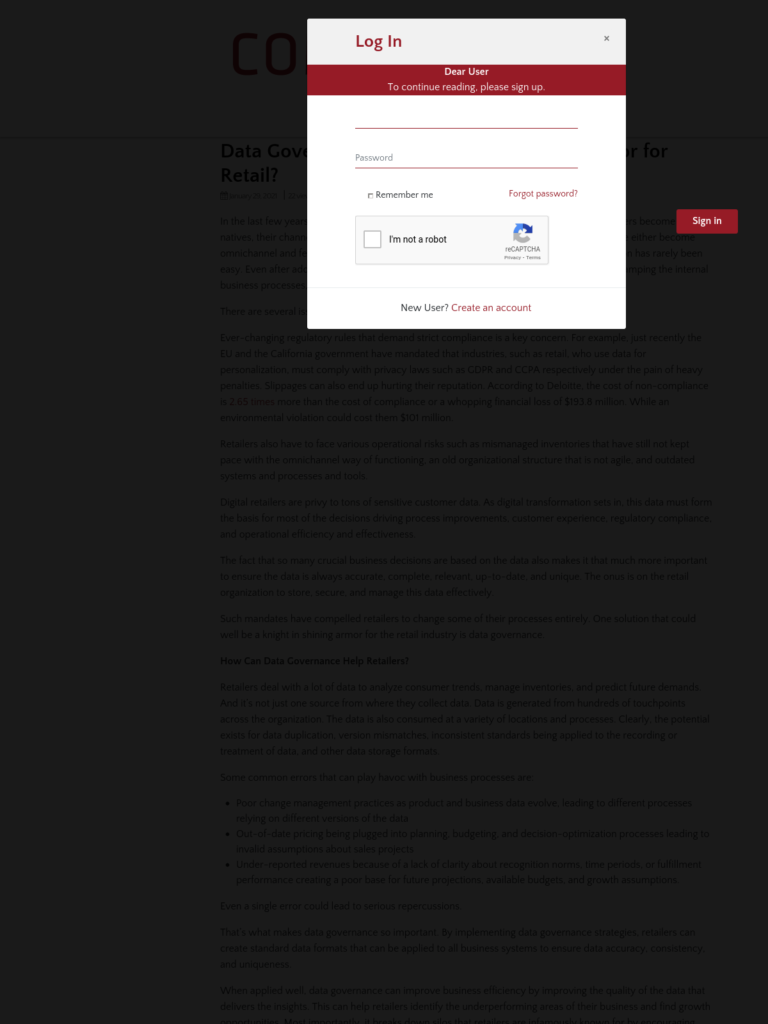Data Governance – the Knight in Shining Armor for Retail?
Blog: NASSCOM Official Blog
In the last few years, the retail industry has undergone a massive transformation. As customers become digital natives, their channel preferences and buying habits change. In response, most retailers have either become omnichannel and few have transformed into fully digital entities. However, the transformation has rarely been easy. Even after addressing the challenges of choosing the right technology bundles and revamping the internal business processes, concerns about the data that drives the digital transformation remains.
There are several issues to address.
Ever-changing regulatory rules that demand strict compliance is a key concern. For example, just recently the EU and the California government have mandated that industries, such as retail, who use data for personalization, must comply with privacy laws such as GDPR and CCPA respectively under the pain of heavy penalties. Slippages can also end up hurting their reputation. According to Deloitte, the cost of non-compliance is 2.65 times more than the cost of compliance or a whopping financial loss of $193.8 million. While an environmental violation could cost them $101 million.
Retailers also have to face various operational risks such as mismanaged inventories that have still not kept pace with the omnichannel way of functioning, an old organizational structure that is not agile, and outdated systems and processes and tools.
Digital retailers are privy to tons of sensitive customer data. As digital transformation sets in, this data must form the basis for most of the decisions driving process improvements, customer experience, regulatory compliance, and operational efficiency and effectiveness.
The fact that so many crucial business decisions are based on the data also makes it that much more important to ensure the data is always accurate, complete, relevant, up-to-date, and unique. The onus is on the retail organization to store, secure, and manage this data effectively.
Such mandates have compelled retailers to change some of their processes entirely. One solution that could well be a knight in shining armor for the retail industry is data governance.
How Can Data Governance Help Retailers?
Retailers deal with a lot of data to analyze consumer trends, manage inventories, and predict future demands. And it’s not just one source from where they collect data. Data is generated from hundreds of touchpoints across the organization. The data is also consumed at a variety of locations and processes. Clearly, the potential exists for data duplication, version mismatches, inconsistent standards being applied to the recording or treatment of data, and other data storage formats.
Some common errors that can play havoc with business processes are:
- Poor change management practices as product and business data evolve, leading to different processes relying on different versions of the data
- Out-of-date pricing being plugged into planning, budgeting, and decision-optimization processes leading to invalid assumptions about sales projects
- Under-reported revenues because of a lack of clarity about recognition norms, time periods, or fulfillment performance creating a poor base for future projections, available budgets, and growth assumptions.
Even a single error could lead to serious repercussions.
That’s what makes data governance so important. By implementing data governance strategies, retailers can create standard data formats that can be applied to all business systems to ensure data accuracy, consistency, and uniqueness.
When applied well, data governance can improve business efficiency by improving the quality of the data that delivers the insights. This can help retailers identify the underperforming areas of their business and find growth opportunities. Most importantly, it breaks down silos that retailers are infamously known for by encouraging collaboration between different stakeholders within the organization.
To bring in data governance, retailers will have to use data harmonization. Retailers collect data across different geographies and channels. If these data sets are not harmonized, errors, duplications, inconsistent standards, and openings for non-compliance creep in. For example, internal systems and markets can view the same data in different ways depending on their requirements. The insights derived from this data can be incorrect and prove to be disastrous to downstream policies.
That’s why data harmonization is so important. It helps to:
- Bring accuracy in data reporting
- Identify risks and predict future business outcomes
- Streamline business operations
- Improve compliance
Investing time and efforts in harmonizing the data helps ensure there are no misalignments in data sources, no conflicts in ideas, and no inconsistencies in reporting. As it happens, although data harmonization is crucial for the growth of retail companies, a poorly harmonized data set is worse than not having any data at all. Also, though data harmonization helps to standardize data sets, it is not the same as data standardization. Data harmonization helps retailers to synchronize data sets across different channels, geographies, and products.
In a Nutshell
There’s little debate about the importance of Data Governance in the retail sector. Similarly, there’s also little doubt that this is hard to get right. That’s why it’s crucial to work with a partner who understands these processes and distinctions well and brings in tools, processes, and methods to manage, govern, and harmonize the data sets effectively. The right partner should be able to guide the retailer towards the harmonization journey and set up governance processes so they can reduce the operational risks and abide by the changing compliance norms. As the retail industry undergoes more changes in the future, the regulations will change and so will the way the sector functions. Hence, it’s good to be prepared to establish a culture of data governance to drive improved business outcomes.
The post Data Governance – the Knight in Shining Armor for Retail? appeared first on NASSCOM Community |The Official Community of Indian IT Industry.
Leave a Comment
You must be logged in to post a comment.








